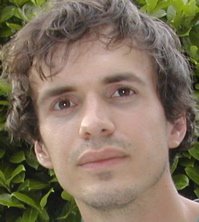The Kavre school is a concrete two story building with about forty students. Laborers were building a brick walkway from the rutted road to the courtyard. In the monsoon, the yard was a slurry of mud. The older students were in a classroom on the second floor, making candles for Dasein. The wax was mixed with coloring and then poured into a mold. These candles would be sold in the marketplace and the proceeds would go back to the school. While the students made candles, an old deaf man stood in the doorway, watching us. He was unmarried, living on his own, and he'd made his living through menial labor-- farming land belonging to others and portering loads. Though he had many brothers and sisters, I had the feeling that he couldn't rely on them. He stood in the doorway as if watching from an another world. In comparison, these students have much better prospects.
One of the things that most intrigues me is this gap between generations of deaf here in Nepal. The experiences of this older generation resonates with me. While I've been incredibly fortunate in this life, I still recognize the feeling of isolation in these older deaf Nepalis, who are just now struggling to learn Nepali Sign Language. Because I was “mainstreamed” growing up, I was the only deaf student in my school. Deaf schools are a strong foundation for Deaf culture in both America and Nepal, but as the only deaf student in a hearing school, I grew up profoundly aware of how I was different and how being deaf often created barriers between myself and others. It's a moving experience to meet a seventy year old man who is learning NSL for the first time, as I did during my first few weeks in Kathmandu. He'd been a tailor, and when I was told that he'd started learning sign language in August, a month before, I thought I was misunderstanding. I can only imagine what it must be like to finally be able to communicate after all that time.
After the Kavre students finished making candles, they started on lunch. Three of the girls prepared dough and rolled chapatis, while one of the older boys, whose sign name means “yawn,” boiled potatoes. They cooked a meal for forty students using only two burners-- a simple but delicious chickpea and potato curry.
In the afternoon, I had the chance to see the traditional dances that the girls were learning. The principal, who is hearing, played the music on a tape recorder and used her hands to indicate the beat. There were both Tamang and Newari dances.
It's amazing how enthusiastic the teachers are; currently they only have enough funding for two teachers, which is being split between five people.

Deaf Students at the Kavre School
